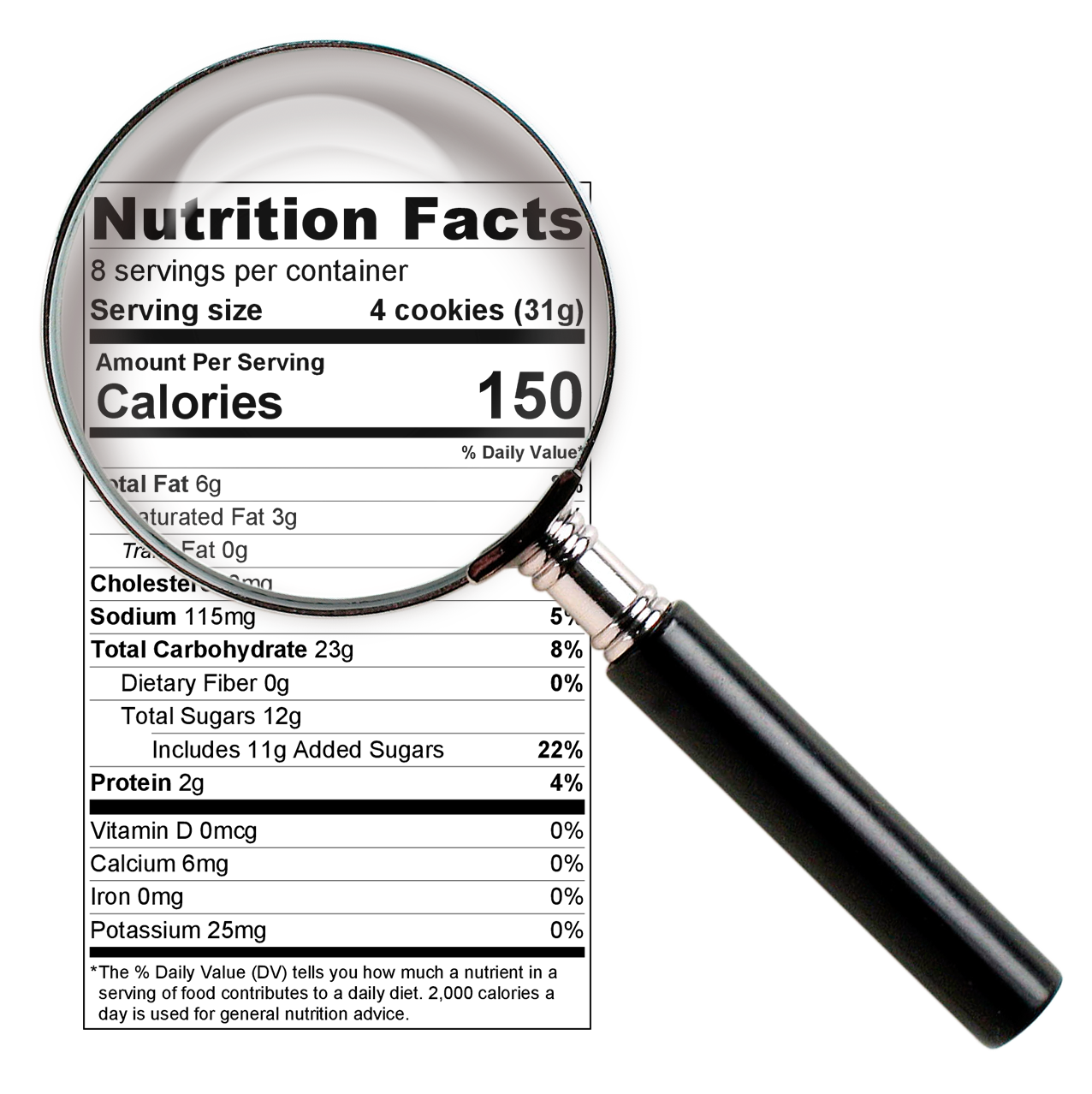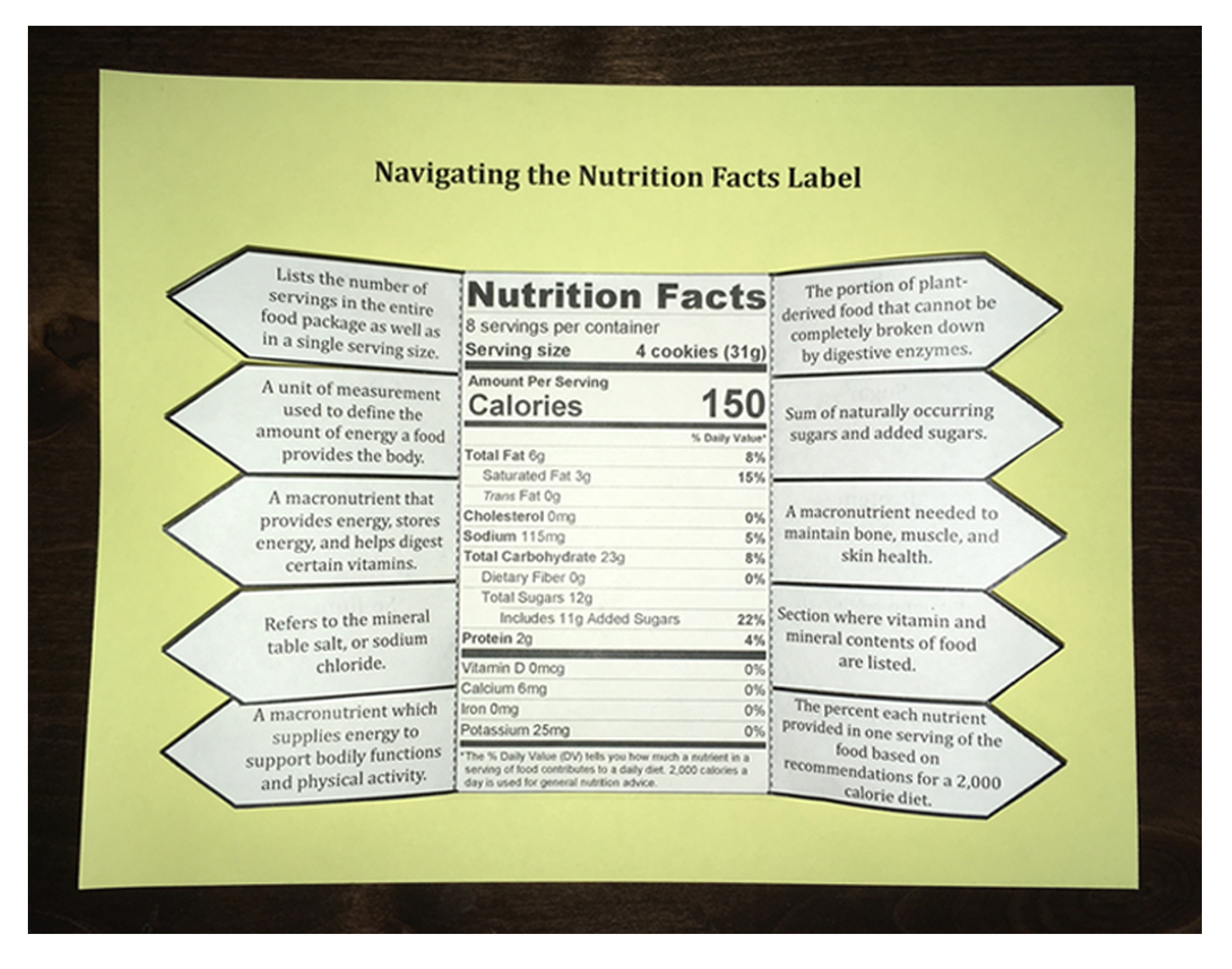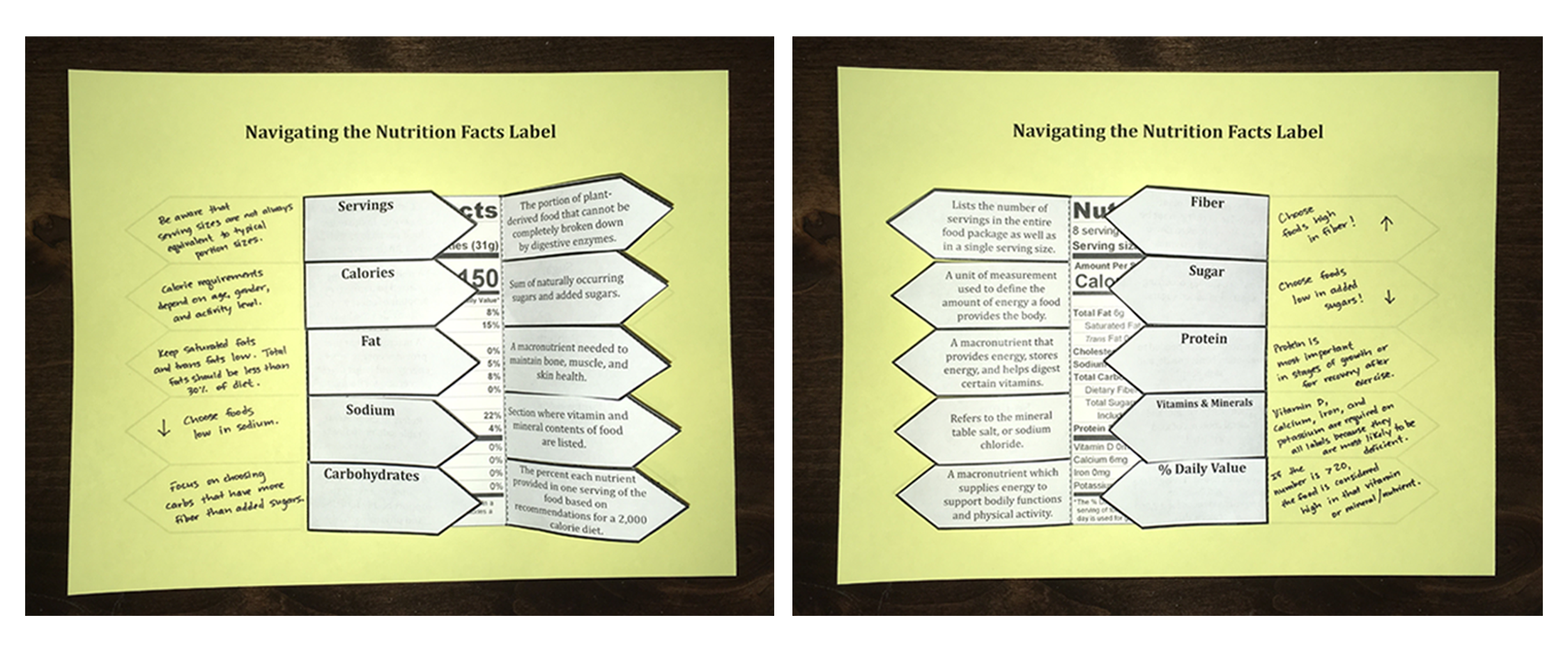Agricultural Literacy Curriculum Matrix
Lesson Plan
What's On The Nutrition Facts Label?
Grade Level
Purpose
Students will be introduced to the Nutrition Facts label, navigate and decipher the Nutrition Facts label, use food labels to determine nutritive value of foods, and define terminology found on the label such as calories, nutrients, and servings. Grades 9-12
Estimated Time
Materials Needed
Engage:
- 8-10 food packages (a variety of food types)
Activity 1: Navigating the Nutrition Facts Label
- Navigating the Nutrition Facts Label PowerPoint slides
- Navigating the Nutrition Facts Label handout, 1 per student
- Foldable Notes cutout page, 1 per student printed front to back
- Student access to scissors, glue/tape, and colored pencils
- Food Label Smarts video
Activity 2: Ranking Food Labels
- Nutrition Facts Label Cards, 1 copy/set per group of 3-4 students (cut each sheet in half to make 10 cards)
Vocabulary
Food and Drug Administration (FDA): a federal agency in the United States responsible for protecting the public health by ensuring the safety, efficacy, and security of human and veterinary drugs, biological products, medical devices, and the safety of our nation's food supply
Nutrition Facts: a label required by law on food packages indicating the nutritional composition of the food
Did You Know?
- Food manufacturers determine the nutrient contents of their own products to indicate on the Nutrition Facts label. The FDA does not initially check for accuracy, but they collect samples to monitor accuracy of the information provided. 1
- In 1862, President Abraham Lincoln signed into law the United States Department of Agriculture. Lincoln called the USDA “The People’s Department” because it touches the lives of every American, every day. The USDA still fulfills this mission overseeing the production of our food.2
- The origin of the FDA traces back to the 1906 Pure Food and Drugs Act.3
Background Agricultural Connections
In the 1960s, most Americans were preparing their food at home from scratch. Within a few years, the demand and cultural preferences began shifting toward prepared and prepackaged foods. After outbreaks of food borne illness and growing allergy concerns, consumers wanted more information about the packaged food they were buying. The Nutrition Facts label was the solution. The Nutrition Facts label has been printed on retail foods since the 1960s. Nutrition labels are standardized and regulated by the Food and Drug Administration (FDA) for consistency and accuracy.
The last major change to the Nutrition Facts label was initiated in 2016. Food companies have until January 2020 to implement the food label changes, so both label formats may be found until then.
Changes were developed based on new scientific research and an effort to help consumers connect their dietary choices with chronic disease. The new food label is designed to be easier for consumers to read and understand, allowing them to make more informed choices about the food they eat. Changes include the following:
- The type size has been increased and bolded for “calories,” “servings per container,” and “serving size.”
- The Daily Values (% DV) footnote has been updated to define what Daily Value means.
- The amount of sugars in the form of syrup, sugar, honey, or sugars from concentrated fruit or vegetable juice is included in a new section of the label called “Added Sugars.” This new addition to the label was added because research has shown it is difficult to stay under your calorie intake if you are consuming more than 10% of your diet in added sugar.
- Vitamin D, potassium, calcium, and iron are now required nutrients to be listed on the nutrition label. They are listed both in percent Daily Value (DV) and measured by weight (mg or mcg).
- “Calories from Fat” has been removed because it is more important to know the type of fat you are consuming.
- Serving sizes will be based on the amount people are actually eating. Typical serving sizes have increased over the years. For example, a serving of ice cream used to be 1/2 cup, but it will now be 2/3 cup.
Nutrition Facts labels are important tools to help consumers be aware of the contents of their foods in order to meet and not exceed their nutrition requirements. Food labels contain the following information:
- Servings Per Container: Shows the total number of servings found in the entire package.
- Serving Size: This quantity is based on the amount customarily eaten at one time, though typical serving sizes often exceed recommended serving sizes.
- Calories: A unit of measurement used to define the amount of energy a food provides the body.
- Fat: A macronutrient that provides energy, stores energy, and helps digest fat-soluble vitamins. There are four types of fat; polyunsaturated fat, monounsaturated fat, saturated fat, and trans fat.
- Sodium: Refers to the mineral table salt, or sodium chloride. Sodium helps in the function of nerves, muscles, and fluid balance in the body.
- Carbohydrate: A macronutrient which supplies energy to support bodily functions and physical activity. Carbohydrates include sugars, starches, celluloses, and gums.
- Fiber: The portion of plant-derived food that cannot be completely broken down by digestive enzymes. Fiber improves digestive health and lowers risk of many chronic diseases.
- Sugar: The sum of naturally occurring sugars and added sugars in a food. Naturally occurring sugars would include fructose in fruit or lactose in dairy products. Added sugars are those added in the processing of food in the form of table sugar, honey, syrups, etc.
- Protein: A macronutrient needed to maintain bone, muscle, and skin health.
- Vitamins and Minerals: This section declares the amount of vitamins or minerals found in each serving of food. Vitamin D, calcium, iron, and potassium are required on the label because they have been found to be most at risk of being deficient in the United States.
- % Daily Value: The percent of each nutrient provided in one serving of the food based on recommendations for a 2,000 calorie diet.
Engage
 Before class, gather 8-10 different food products, and display them on a table or countertop where your class can see them.
Before class, gather 8-10 different food products, and display them on a table or countertop where your class can see them.- At the beginning of class, challenge the students to place the food in order from the greatest to the least amount of sugar per serving. You may choose to invite one or two students to categorize the food in front of the class or seek input from your entire class to accomplish the task together.
- Give student(s) 1-2 minutes to complete the challenge. After student(s) finish, ask how they came to their conclusion. If the students did not use the Nutrition Facts labels on the food packages, ask the class, “Is there a way to obtain this information about the food we eat? (Yes, the Nutrition Facts label.)
- Use the Nutrition Facts labels to check the accuracy of the food ranking. Show students where the nutrition labels can be found on the food packages. Ask students if any of the food surprised them by having more or less sugar than they imagined.
- Explain that nearly every packaged food sold in a grocery store is required to have a food label. Ask the students why they think it is important to have labels on the food we eat. (To know the amount of sugar/fat and other nutrients, for consumers to address specific health concerns impacted by their diet, or to avoid food they are allergic to.)
Explore and Explain
Activity 1: Navigating the Nutrition Facts Label
- Stimulate thinking about the Nutrition Facts labels by asking, “Besides raw, unpackaged produce and some fresh fish and meat cuts, what foods can you find at the grocery store that are NOT required to have a Nutrition Facts label?” (Foods that contain insignificant amounts [zero] of all required nutrients. Examples include tea, coffee, food coloring, and spices.) If students do not come up with the correct answer, offer an incentive to the person who comes to the next class with the answer.
- Give each student one copy of the Navigating the Nutrition Facts Label handout and one copy of the Foldable Notes cutout page (printed front to back).
- Instruct students to cut out the Foldable Notes page and glue or tape it to their handout. Show them an example and remind them to cut along the solid lines and fold on the dotted lines.

- Ask students why it is important to be able to read and understand a Nutrition Facts label? (To know the amount of nutrients we are putting into our bodies, to avoid under or over nourishment, and to help us be educated about the foods we are eating.)
- Project the Navigating the Nutrition Facts Label PowerPoint and use it as a guide for a discussion with your students. Introduce and explain each portion of the Nutrition Facts label. Instruct students to add some notes to their handout under each tab (see example below).

- Summarize that the Nutrition Facts label helps us eat and live healthier as we are more informed about the nutrient content of our food. Watch, Food Label Smarts.
Activity 2: Ranking Food Labels
- Divide the class into groups of 3-4 students. Give each group one set of Nutrition Facts Label Cards. (They should have 10 cards per group.)
- Explain to the students that they will be evaluating each nutrition label and ranking the foods according to different parameters. Direct the activity with the entire class, or provide a task list for individual groups to work independently.
- Use as many categorizing activities as time allows. Examples include:
- Rank from highest to lowest
- Number of calories
- Total fat
- Sodium
- Dietary Fiber
- Total sugars
- Added sugars
- Protein
- Vitamin D
- Calcium
- Iron
- Potassium
- Compare or find correlations
- Is there any correlation between total carbohydrates and total sugars? (Yes, sugars are a specific type of carbohydrate. Foods high in sugar are often also high in carbohydrates.)
- Which food provides a significant source (20% or greater) of one of the 4 vitamins/minerals (Vitamin D, potassium, calcium, and iron)? (Cheese pizza-calcium)
- What is unique or different about the Oats and Honey Clusters label? (Explain to students the use of the dual column label. Certain food products that can be eaten in one sitting have a dual column label listing the calories and nutrients per serving as well as per package.)
- Rank from highest to lowest
- Ask follow up questions such as, "Did anything surprise you about these foods?" or "What questions do you have?"
Elaborate
-
Students have just learned about the Nutrition Facts label found on the side or back of food packages. Many food packages also have nutritional health claims that are often found on the front of food packages. Read Health Claims on Food Labels to expand knowledge of the information found on the front of food packages.
-
Have students construct their own food label for their favorite recipe. Use the Creating a Nutrition Facts Label worksheet for guidance.
-
Watch the video clip, What is a calorie?
Evaluate
After conducting these activities, review and summarize the follow key concepts:
- Government organizations such as the FDA oversee the labeling of foods in the United States. They set standards for food processing companies to follow to communicate nutrition facts to consumers.
- Accurately reading a Nutrition Facts label and using the information to follow dietary recommendations can help lead to a healthier diet and lifestyle.
- A variety of foods can contribute to a healthy diet.
- All foods are required to have a Nutrition Facts label with the exception of raw produce, some fresh meat cuts, and foods with zero nutritional content such as coffee, tea, or spices.
Sources
- https://guidingstars.com/guiding-stars-news/10-surprisingly-unfamiliar-nutrition-facts-label-facts/
- https://www.usda.gov/our-agency/about-usda/history
- https://www.fda.gov/about-fda/fda-basics/when-and-why-was-fda-formed
Recommended Companion Resources
Author
Organization
| We welcome your feedback! If you have a question about this lesson or would like to report a broken link, please send us an email at matrixelearning@gmail.com. If you have used this lesson and are willing to share your experience, we will provide you with a coupon code for 10% off your next purchase at AgClassroomStore. |


 Photo by Lyndsey Garber
Photo by Lyndsey Garber Photo by NM Department of Agriculture
Photo by NM Department of Agriculture Photo by NM Department of Agriculture
Photo by NM Department of Agriculture Photo by Jay Hill
Photo by Jay Hill Photo by NM Department of Agriculture
Photo by NM Department of Agriculture Photo by Lyndsey Garber
Photo by Lyndsey Garber